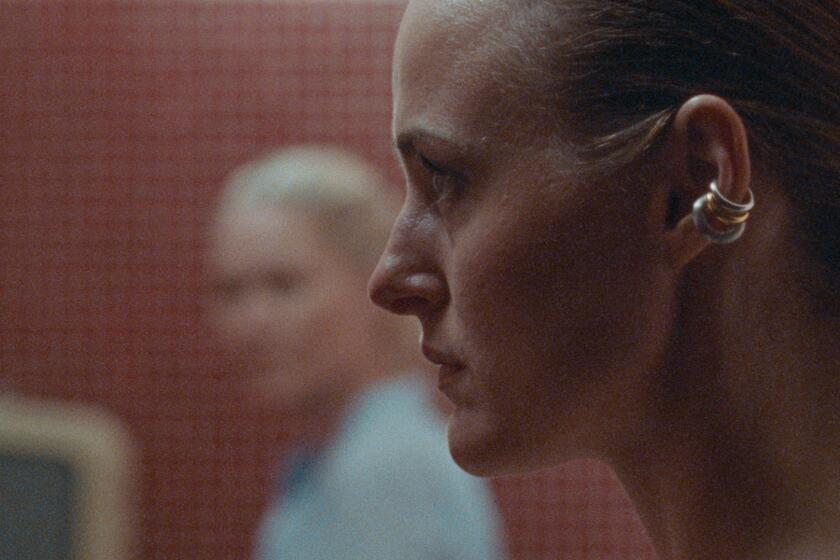A SECOND LOOK
- Share via
After his death last September, Paul Newman received any number of tributes -- for his acting and his humanitarian efforts. Less remembered, and somewhat neglected throughout his career, was his work as a filmmaker. Newman, who majored in directing at the Yale Drama School, ventured behind the camera only on occasion -- he directed six films from the late ‘60s to the late ‘80s, most of them starring his wife, Joanne Woodward.
John Cassavetes and Clint Eastwood notwithstanding, the figure of the actor-turned-director often conjures up the dreaded notion of the vanity project. But the best of Newman’s movies -- humane but unsentimental, modest bordering on inconspicuous -- were the very opposite of vain.
“Rachel, Rachel,” Newman’s directing debut from 1968 and out on DVD for the first time this week, earned Academy Award nominations for best picture, for Woodward and her costar Estelle Parsons, and for screenwriter Stewart Stern. But the movie has since slipped into semi-obscurity, apparently a casualty of changing tastes.
Based on “A Jest of God,” a novel by Canadian author Margaret Laurence, this low-key portrait of a lonely woman in a sleepy backwater might have seemed quaint or uncool at the time, removed as it was from the political foment and countercultural fashions of the day.
The film unfolds over the course of a fateful summer for unmarried schoolteacher Rachel Cameron (Woodward). At 35, she finds herself in a depressive, contemplative mood. She views the idle months ahead with apprehension -- “my last ascending summer,” she calls it, before the downhill slide into the grave. On the whole, though, Rachel is prone less to self-pity than to morbid daydreaming. Her father was the local undertaker, and as a child she spent untold hours watching him at work. (The young Rachel is played in flashbacks by Newman and Woodward’s daughter Nell Potts, who would play Woodward’s daughter in another Newman-directed film, 1972’s “The Effect of Gamma Rays on Man-in-the-Moon Marigolds.”)
Rachel’s father is long dead, and her sister has married and moved away, but she and her mother still live above the funeral home. Her daily routine revolves around the needs of her neurotic, overbearing mother, who regards her more or less as a maid. She reflexively shuns the company of others, and her attempts at social interaction are doomed to failure.
She has precisely one confidant, Calla (Parsons), a kindly colleague and closeted lesbian, but that friendship ends in confusion and embarrassment when Calla makes an ill-advised pass at her.
Things seem to pick up when Nick (James Olson), a high school acquaintance, returns to town and sets about seducing her. But the late-blooming idyll is bittersweet -- the viewer senses, long before Rachel does, the unsustainable tension between her raw vulnerability (“It’s such a new experience,” she murmurs, “having contact with anyone”) and Nick’s good-time-boy ease.
Newman’s direction is quiet and unfussy, and the film’s plainness only enhances its clarity, but he also makes room for some unexpected humor and (in Rachel’s death-haunted reveries) touches of macabre poetry. No less than Newman, Woodward resists melodrama at every turn, and she makes a familiar character more complicated than first impressions suggest.
Rachel is guarded and stoic, but Woodward also reveals the girlish romanticism and the depth of emotion that, through habit or instinct, she has come to repress. It’s a superbly reined-in performance in the service of a fully fleshed-out character, treated without the slightest hint of scorn or pity.
Warner Home Video also is issuing four lesser-known (and less-than-distinguished) titles starring Newman this week. In “The Helen Morgan Story” (1957), Michael Curtiz’s biopic of the torch singer, he plays the bootlegger boyfriend opposite Ann Blyth. “The Outrage” (1964) is a western spin on Akira Kurosawa’s seminal “Rashomon,” directed by Martin Ritt, with whom Newman had worked on several films, including the previous year’s “Hud.” “When Time Ran Out” (1980) is a forgettable late entry in the cycle of all-star disaster movies that began in the 1970s.
Of the four, the most intriguing curio is the chintzy religious epic “The Silver Chalice” (1954), Newman’s first film, notable mainly as an example of how his good humor worked to his advantage. While most actors would have hoped that an ignominious Hollywood debut would simply be forgotten, he took out an ad in Variety apologizing for his performance.
--
More to Read
Only good movies
Get the Indie Focus newsletter, Mark Olsen's weekly guide to the world of cinema.
You may occasionally receive promotional content from the Los Angeles Times.










